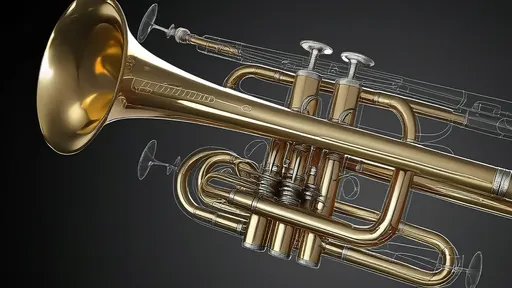The world of musical acoustics is a fascinating intersection of physics and artistry, where the laws of nature conspire to create beauty. Among the most intriguing phenomena in this realm is the harmonic series produced by string instruments – that celestial sequence of tones that seems to emerge like magic from a single plucked string. This natural overtone series forms the acoustic foundation upon which centuries of musical theory and instrument design have been built.
When a violinist draws their bow across a string or a guitarist plucks a taut nylon strand, what we perceive as a single pitch is actually a complex amalgamation of vibrations. The string doesn't merely oscillate as a whole; it divides itself into precise fractions, vibrating simultaneously in halves, thirds, quarters, and beyond. These fractional vibrations produce what we call harmonics or overtones - the ghostly higher pitches that give each instrument its distinctive timbre.
The physics behind this phenomenon reveals nature's elegant mathematical order. A string fixed at both ends can only sustain vibrations that fit perfectly between its termination points. The fundamental frequency (what we identify as the main pitch) occurs when the entire string length vibrates as one segment. The first harmonic appears when the string divides into two equal parts, producing a pitch exactly one octave higher. Subsequent harmonics continue this pattern with ever-smaller divisions, creating a ladder of pitches that theoretically extends into infinity.
What makes the harmonic series particularly remarkable is its universal consistency across all string instruments. Whether it's a massive double bass or a tiny violin, the same physical principles govern their overtone production. The differences in timbre between instruments arise not from the sequence of harmonics itself, but from the relative strengths of these harmonics and how the instrument's body amplifies and colors them.
Skilled musicians harness these acoustic principles through techniques like artificial harmonics. By lightly touching a string at specific nodal points while bowing or plucking, players can isolate individual harmonics that would normally be buried in the complex overtone series. This technique expands the instrument's range upward and creates those ethereal, flute-like tones that seem to float above the normal register.
The harmonic series also explains why certain intervals sound more consonant than others. The octave, perfect fifth, and major third - the building blocks of Western harmony - all appear early in the natural overtone sequence. More complex intervals emerge later in the series, corresponding to our perception of increasing dissonance. This acoustic reality shaped the evolution of musical scales and harmony throughout history.
Modern luthiers must carefully consider harmonic behavior when designing instruments. The placement of soundholes, the thickness of the top plate, even the varnish applied to the wood - all these factors influence how an instrument enhances or suppresses various harmonics. A master violin maker doesn't just carve wood; they sculpt the harmonic spectrum itself, balancing the strength of fundamental tones against the shimmer of higher overtones.
Digital technology has given us new ways to visualize and understand harmonic phenomena. Spectral analysis software can decompose a single violin note into its constituent harmonics, displaying them as peaks on a frequency graph. Such tools reveal why two instruments playing the same written pitch can sound entirely different - their harmonic profiles tell unique acoustic stories. This technology also helps instrument makers quantify what was once purely a matter of artisan intuition.
The harmonic series even influences how we tune instruments. Pure intervals derived from the harmonic series create beatless consonances, but attempting to build an entire scale from these perfect ratios leads to mathematical inconsistencies. This dilemma spawned centuries of tuning system evolution, from meantone temperament to equal temperament, each representing a different compromise between harmonic purity and practical flexibility.
In performance, understanding harmonics allows musicians to produce cleaner tones and better intonation. When playing double stops (two notes simultaneously), violinists can listen for the shared harmonics between the notes to ensure perfect tuning. Cellists use the sympathetic vibration of open strings' harmonics to check their finger placement. These techniques all rely on the predictable behavior of the harmonic series.
The study of string harmonics continues to yield new insights. Recent research explores how nonlinear effects in string vibration might explain certain characteristics of instrument sound that traditional linear models can't account for. Other investigations examine how materials like carbon fiber affect harmonic production compared to traditional wood. Each discovery deepens our understanding of these ancient instruments while informing the development of new ones.
From the gut strings of Baroque instruments to the steel cores of modern orchestral strings, the harmonic series remains the invisible framework that gives stringed instruments their voice. It's a natural phenomenon that connects the physics laboratory to the concert hall, demonstrating how deeply our musical aesthetics are rooted in the fundamental laws of vibration and resonance. The next time you hear a soaring violin melody or a resonant cello tone, listen closely - you're hearing centuries of acoustic wisdom vibrating through time.

By /Jul 25, 2025

By /Jul 25, 2025

By /Jul 25, 2025

By /Jul 25, 2025

By /Jul 25, 2025

By /Jul 25, 2025

By /Jul 25, 2025

By /Jul 25, 2025

By /Jul 25, 2025

By /Jul 25, 2025

By /Jul 25, 2025

By /Jul 25, 2025

By /Jul 25, 2025

By /Jul 25, 2025

By /Jul 25, 2025

By /Jul 25, 2025

By /Jul 25, 2025

By /Jul 25, 2025